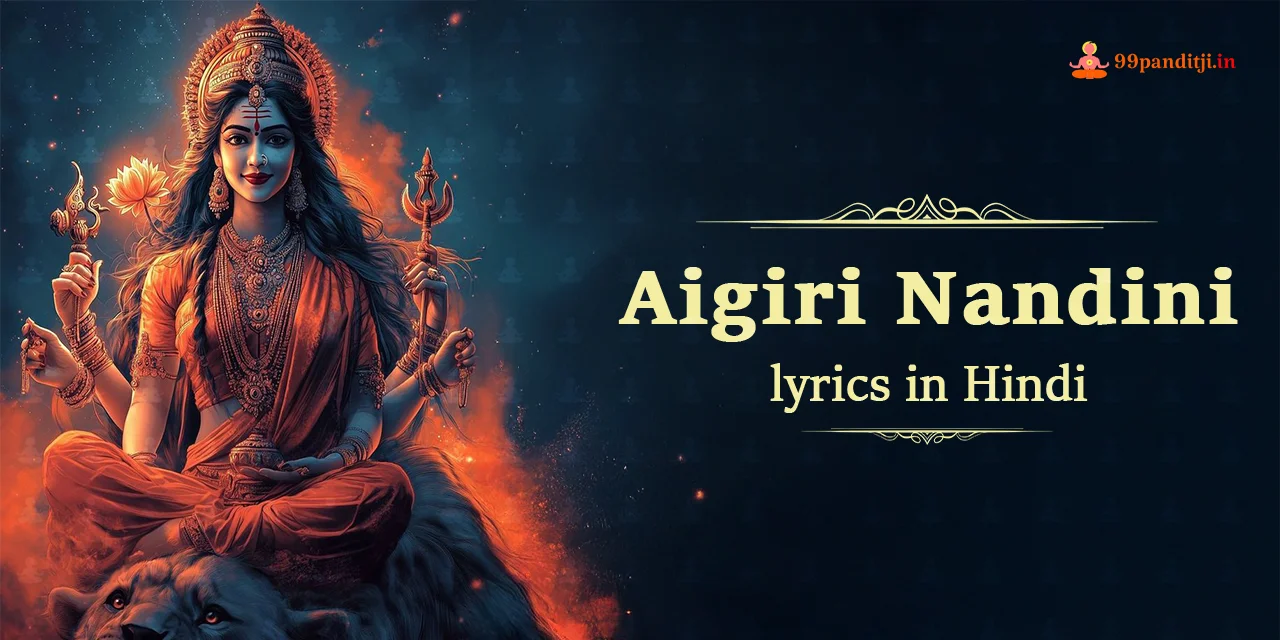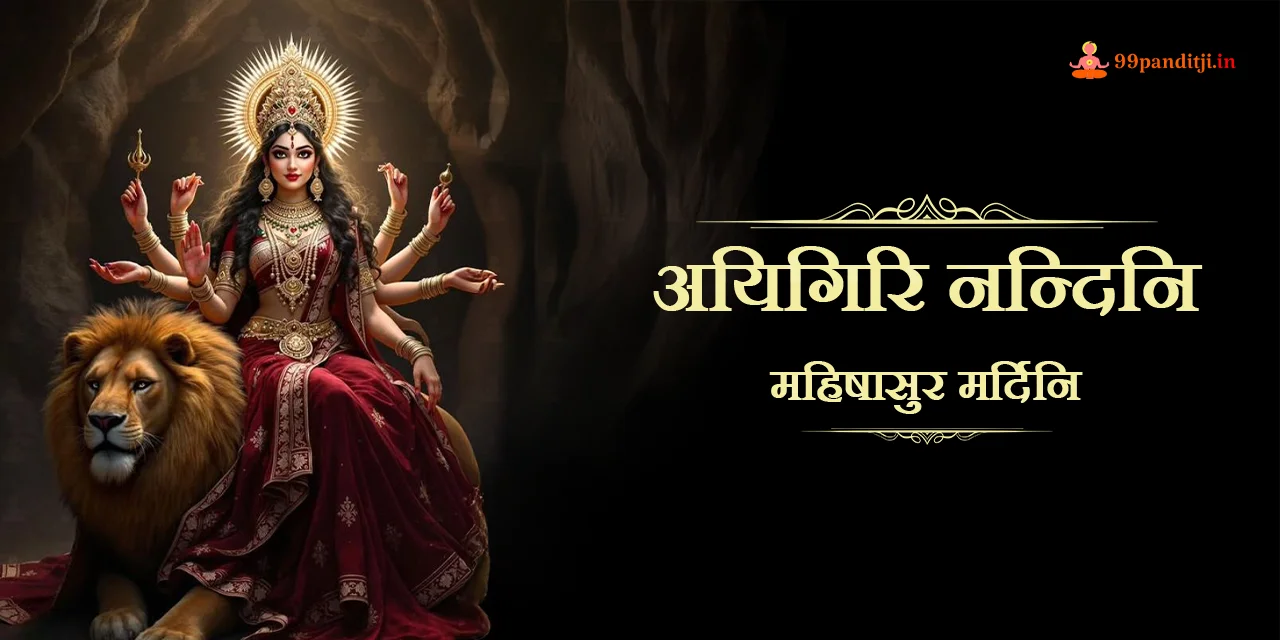अयिगिरि नन्दिनि (Aigiri Nandini Lyrics in Hindi) दुर्गा देवी का एक बहुत लोकप्रिय भक्ति स्तोत्र है। इसे महिषासुर मर्दिनी स्तोत्रम या महिषासुर मर्दिनी श्लोक कहा जाता है। यह भक्ति गीत देवी महिषासुर मर्दिनी को संबोधित है, देवी जिन्होंने राक्षस महिषासुर का वध किया था।
अयिगिरि नन्दिनि (Aigiri Nandini Lyrics in Hindi) गुरु आदि शंकराचार्य (श्री श्री श्री शंकर भगवत्पादाचार्य) द्वारा लिखित देवी दुर्गा का एक बहुत लोकप्रिय भक्ति स्तोत्र है। यह भक्ति छंद देवी महिषासुर मर्दिनी को संबोधित है, देवी जिन्होंने राक्षस महिषासुर का वध किया था।
महिषासुर मर्दिनी देवी दुर्गा माँ (देवी पार्वती का अवतार) का उग्र रूप है, जहाँ दुर्गा माँ को 10 भुजाओं के साथ दर्शाया गया है जो शेर या बाघ की सवारी करती हैं और हथियार रखती हैं और प्रतीकात्मक हाथ के इशारे या मुद्राएँ बनाती हैं।
देवी दुर्गा क्रोध, भय, अहंकार और क्रोध पर विजय प्राप्त करने वाली हैं। जो लोग इन सभी से जूझ रहे हैं, वे खुद को देवी के सामने समर्पित कर सकते हैं।
आज इस ब्लॉग के साथ हम अयिगिरि नन्दिनि स्तोत्र के लिरिक्स (Aigiri Nandini Lyrics in Hindi) जानेंगे। इसके साथ आप किसी प्रकार की पूजा के लिए पंडित बुक करने के लिए जुड़ें 99Pandit के साथ या ‘Book a Pandit’ पर क्लिक करके पंडित बुक करें।
अयिगिरि नन्दिनि लिरिक्स हिंदी में / Aigiri Nandini Lyrics in Hindi
अयिगिरि नन्दिनि नन्दितमेदिनि विश्वविनोदिनि नन्दिनुते
गिरिवरविन्ध्यशिरोधिनिवासिनि विष्णुविलासिनि जिष्णुनुते
भगवति हे शितिकण्ठकुटुम्बिनि भूरिकुटुम्बिनि भूरिकृते
जय जय हे महिषासुर मर्दिनि रम्यकपर्दिनि शैलसुते ॥ १ ॥
सुरवरवर्षिणि दुर्धरधर्षिणि दुर्मुखमर्षिणि हर्षरते
त्रिभुवनपोषिणि शङ्करतोषिणि किल्बिषमोषिणि घोषरते
दनुजनिरोषिणि दितिसुतरोषिणि दुर्मदशोषिणि सिन्धुसुते
जय जय हे महिषासुर मर्दिनि रम्यकपर्दिनि शैलसुते ॥ २ ॥
अयि जगदम्ब मदम्ब कदम्बवनप्रियवासिनि हासरते
शिखरिशिरोमणितुङ्गहिमालयशृङ्गनिजालयमध्यगते
मधुमधुरे मधुकैटभगञ्जिनि कैटभभञ्जिनि रासरते
जय जय हे महिषासुर मर्दिनि रम्यकपर्दिनि शैलसुते ॥ ३ ॥
अयि शतखण्ड विखण्डितरुण्ड वितुण्डितशुण्ड गजाधिपते
रिपुगजगण्ड विदारणचण्ड पराक्रमशुण्ड मृगाधिपते
निजभुजदण्ड निपातितखण्डविपातितमुण्डभटाधिपते
जय जय हे महिषासुर मर्दिनि रम्यकपर्दिनि शैलसुते ॥ ४ ॥
अयि रणदुर्मद शत्रुवधोदित दुर्धरनिर्जर शक्तिभृते
चतुरविचारधुरीण महाशिव दूतकृत प्रमथाधिपते
दुरितदुरीहदुराशयदुर्मतिदानवदूतकृतान्तमते
जय जय हे महिषासुर मर्दिनि रम्यकपर्दिनि शैलसुते ॥ ५ ॥
अयि शरणागतवैरिवधूवर वीरवराभयदायकरे
त्रिभुवन मस्तक शूलविरोधिशिरोधिकृतामल शूलकरे
दुमिदुमितामर दुन्दुभिनाद महो मुखरीकृत तिग्मकरे
जय जय हे महिषासुर मर्दिनि रम्यकपर्दिनि शैलसुते ॥ ६ ॥
अयि निजहुङ्कृतिमात्र निराकृत धूम्रविलोचन धूम्रशते
समरविशोषित शोणितबीज समुद्भवशोणित बीजलते
शिव शिव शुम्भ निशुम्भ महाहव तर्पित भूत पिशाचरते
जय जय हे महिषासुर मर्दिनि रम्यकपर्दिनि शैलसुते ॥ ७ ॥
धनुरनुसङ्ग रणक्षणसङ्ग परिस्फुरदङ्ग नटत्कटके
कनक पिशङ्गपृषत्कनिषङ्गरसद्भट शृङ्ग हतावटुके
कृतचतुरङ्ग बलक्षितिरङ्ग घटद्बहुरङ्ग रटद्बटुके
जय जय हे महिषासुर मर्दिनि रम्यकपर्दिनि शैलसुते ॥ ८ ॥
सुरललना ततथेयि तथेयि कृताभिनयोदर नृत्यरते
कृत कुकुथः कुकुथो गडदादिकताल कुतूहल गानरते
धुधुकुट धुक्कुट धिन्धिमित ध्वनि धीर मृदङ्ग निनादरते
जय जय हे महिषासुर मर्दिनि रम्यकपर्दिनि शैलसुते ॥ ९ ॥
जय जय जप्य जये जय शब्दपरस्तुति तत्पर विश्वनुते
भण भण भिञ्जिमि भिङ्कृतनूपुर सिञ्जितमोहित भूतपते
नटितनटार्ध नटीनटनायक नाटितनाट्य सुगानरते
जय जय हे महिषासुर मर्दिनि रम्यकपर्दिनि शैलसुते ॥ १० ॥
अयि सुमनः सुमनः सुमनः सुमनः सुमनोहर कान्तियुते
श्रित रजनी रजनी रजनी रजनी रजनीकर वक्त्रवृते
सुनयन विभ्रमर भ्रमर भ्रमर भ्रमर भ्रमराधिपते
जय जय हे महिषासुर मर्दिनि रम्यकपर्दिनि शैलसुते ॥ ११ ॥
सहित महाहव मल्लम तल्लिक मल्लित रल्लक मल्लरते
विरचित वल्लिक पल्लिक मल्लिक भिल्लिक भिल्लिक वर्ग वृते
सितकृत पुल्लिसमुल्लसितारुण तल्लज पल्लव सल्ललिते
जय जय हे महिषासुर मर्दिनि रम्यकपर्दिनि शैलसुते ॥ १२ ॥
अविरलगण्डगलन्मदमेदुर मत्तमतङ्गज राजपते
त्रिभुवनभूषणभूतकलानिधि रूपपयोनिधि राजसुते
अयि सुदतीजन लालसमानस मोहनमन्मथ राजसुते
जय जय हे महिषासुर मर्दिनि रम्यकपर्दिनि शैलसुते ॥ १३ ॥
कमलदलामल कोमलकान्ति कलाकलितामल भाललते
सकलविलास कलानिलयक्रम केलिचलत्कल हंसकुले
अलिकुल सङ्कुल कुवलय मण्डल मौलिमिलद्भकुलालि कुले
जय जय हे महिषासुर मर्दिनि रम्यकपर्दिनि शैलसुते ॥ १४ ॥
करमुरलीरववीजितकूजित लज्जितकोकिल मञ्जुमते
मिलित पुलिन्द मनोहर गुञ्जित रञ्जितशैल निकुञ्जगते
निजगुणभूत महाशबरीगण सद्गुणसम्भृत केलितले
जय जय हे महिषासुर मर्दिनि रम्यकपर्दिनि शैलसुते ॥ १५ ॥
कटितटपीत दुकूलविचित्र मयूखतिरस्कृत चन्द्ररुचे
प्रणतसुरासुर मौलिमणिस्फुरदंशुलसन्नख चन्द्ररुचे
जितकनकाचल मौलिपदोर्जित निर्भरकुञ्जर कुम्भकुचे
जय जय हे महिषासुर मर्दिनि रम्यकपर्दिनि शैलसुते ॥ १६ ॥
विजित सहस्रकरैक सहस्रकरैक सहस्रकरैकनुते
कृत सुरतारक सङ्गरतारक सङ्गरतारक सूनुसुते
सुरथसमाधि समानसमाधि समाधिसमाधि सुजातरते
जय जय हे महिषासुर मर्दिनि रम्यकपर्दिनि शैलसुते ॥ १७ ॥
पदकमलं करुणानिलये वरिवस्यति योऽनुदिनं स शिवे
अयि कमले कमलानिलये कमलानिलयः स कथं न भवेत्
तव पदमेव परम्पदमित्यनुशीलयतो मम किं न शिवे
जय जय हे महिषासुर मर्दिनि रम्यकपर्दिनि शैलसुते ॥ १८ ॥
कनकलसत्कल सिन्धुजलैरनु सिञ्चिनुतेगुण रङ्गभुवं
भजति स किं न शचीकुचकुम्भ तटीपरिरम्भ सुखानुभवम्
तव चरणं शरणं करवाणि नतामरवाणि निवासि शिवं
जय जय हे महिषासुर मर्दिनि रम्यकपर्दिनि शैलसुते ॥ १९ ॥
तव विमलेन्दुकुलं वदनेन्दुमलं सकलं ननु कूलयते
किमु पुरुहूत पुरीन्दुमुखी सुमुखीभिरसौ विमुखीक्रियते
मम तु मतं शिवनामधने भवती कृपया किमुत क्रियते
जय जय हे महिषासुर मर्दिनि रम्यकपर्दिनि शैलसुते ॥ २० ॥
अयि मयि दीनदयालुतया कृपयैव त्वया भवितव्यमुमे
अयि जगतो जननी कृपयासि यथासि तथाऽनुभितासिरते
यदुचितमत्र भवत्युररि कुरुतादुरुतापमपाकुरुते
जय जय हे महिषासुर मर्दिनि रम्यकपर्दिनि शैलसुते ॥ २१ ॥
इति श्री महिषासुर मर्दिनि स्तोत्रम् ||

अयिगिरि नन्दिनि लिरिक्स अंग्रेजी में / Aigiri Nandini Lyrics in English
Ayigiri Nandini Nanditamedini Vishvavinodini Nandinute
Girivaravindhyashiro’dhinivasini Vishnuvilasini Jishnunute।
Bhagavati He Shitikanthakutumbini Bhurikutumbini Bhurikrite
Jaya Jaya He Mahishasuramardini Ramyakapardini Shailasute॥1॥
Suravaravarshini Durdharadharshini Durmukhamarshini Harsharate
Tribhuvanaposhini Shankaratoshini Kilbishamoshini Ghosharate
Danujaniroshini Ditisutaroshini Durmadashoshini Sindhusute
Jaya Jaya He Mahishasuramardini Ramyakapardini Shailasute॥2॥
Ayi Jagadamba Madamba Kadamba Vanapriyavasini Hasarate
Shikhari Shiromani Tungahimalaya Shringanijalaya Madhyagate।
Madhumadhure Madhukaitabhaganjini Kaitabhabhanjini Rasarate
Jaya Jaya He Mahishasuramardini Ramyakapardini Shailasute॥3॥
Ayi Shatakhanda Vikhanditarunda Vitunditashunda Gajadhipate
Ripugajaganda Vidaranachanda Parakramashunda Nrigadhipate।
Nijabhujadanda Nipatitakhanda Vipatitamunda Bhatadhipate
Jaya Jaya He Mahishasuramardini Ramyakapardini Shailasute॥4॥
Ayi Ranadurmada Shatruvadhodita Durdharanirjara Shaktibhrite
Chaturavichara Dhurinamahashiva Dutakrita Pramathadhipate।
Duritaduriha Durashayadurmati Danavaduta Kritantamate
Jaya Jaya He Mahishasuramardini Ramyakapardini Shailasute॥5॥
Ayi Sharanagata Vairivadhuvara Viravarabhaya Dayakare
Tribhuvanamastaka Shulavirodhi Shiro’dhikritamala Shulakare।
Dumidumitamara Dhundubhinadamahomukharikrita Dinmakare
Jaya Jaya He Mahishasuramardini Ramyakapardini Shailasute॥6॥
Ayi Nijahunkriti Matranirakrita Dhumravilochana Dhumrashate
Samaravishoshita Shonitabija Samudbhavashonita Bijalate।
Shivashivashumbha Nishumbhamahahava Tarpitabhuta Pishacharate
Jaya Jaya He Mahishasuramardini Ramyakapardini Shailasute॥7॥
Dhanuranushanga Ranakshanasanga Parisphuradanga Natatkatake
Kanakapishanga Prishatkanishanga Rasadbhatashringa Hatabatuke।
Kritachaturanga Balakshitiranga Ghatadbahuranga Ratadbatuke
Jaya Jaya He Mahishasuramardini Ramyakapardini Shailasute॥8॥
Suralalana Tatatheyi Tatheyi Kritabhinayodara Nrityarate
Krita Kukuthah Kukutho Gadadadikatala Kutuhala Ganarate।
Dhudhukuta Dhukkuta Dhindhimita Dhvani Dhira Nridanga Ninadarate
Jaya Jaya He Mahishasuramardini Ramyakapardini Shailasute॥9॥
Jaya Jaya Japya Jayejayashabda Parastuti Tatparavishvanute
Jhanajhanajhinjhimi Jhinkrita Nupurashinjitamohita Bhutapate।
Natita Natardha Nati Nata Nayaka Natitanatya Suganarate
Jaya Jaya He Mahishasuramardini Ramyakapardini Shailasute॥10॥
Ayi Sumanahsumanahsumanah Sumanahsumanoharakantiyute
Shritarajani Rajanirajani Rajanirajani Karavaktravrite।
Sunayanavibhramara Bhramarabhramara Bhramarabhramaradhipate
Jaya Jaya He Mahishasuramardini Ramyakapardini Shailasute॥11॥
Sahitamahahava Mallamatallika Mallitarallaka Mallarate
Virachitavallika Pallikamallika Jhillikabhillika Vargav
Shitakritaphulla Samullasitaruna Tallajapallava Sallalite
Jaya Jaya He Mahishasuramardini Ramyakapardini Shailasute॥12॥
Aviralaganda Galanmadamedura Mattamatanga Jarajapate
Tribhuvanabhushana Bhutakalanidhi Rupapayonidhi Rajasute।
Ayi Sudatijana Lalasamanasa Mohana Manmatharajasute
Jaya Jaya He Mahishasuramardini Ramyakapardini Shailasute॥13॥
Kamaladalamala Komalakanti Kalakalitamala Bhalalate
Sakalavilasa Kalanilayakrama Kelichalatkala Hansakule।
Alikulasankula Kuvalayamandala Maulimiladbakulalikule
Jaya Jaya He Mahishasuramardini Ramyakapardini Shailasute॥14॥
Karamuralirava Vijitakujita Lajjitakokila Manjumate
Militapulinda Manoharagunjita Ranjitashaila Nikunjagate।
Nijaganabhuta Mahashabarigana Sadgunasambhrita Kelitale
Jaya Jaya He Mahishasuramardini Ramyakapardini Shailasute॥15॥
Katitatapita Dukulavichitra Mayukhatiraskrita Chandraruche
Pranatasurasura Maulimanisphura Danshulasannakha Chandraruche
Jitakanakachala Maulimadorjita Nirbharakunjara Kumbhakuche
Jaya Jaya He Mahishasuramardini Ramyakapardini Shailasute॥16॥
Vijitasahasrakaraika Sahasrakaraika Sahasrakaraikanute
Kritasurataraka Sangarataraka Sangarataraka Sunusute।
Surathasamadhi Samanasamadhi Samadhisamadhi Sujatarate।
Jaya Jaya He Mahishasuramardini Ramyakapardini Shailasute॥17॥
Padakamalam Karunanilaye Varivasyati Yo’nudinam Sushive
Ayi Kamale Kamalanilaye Kamalanilayah Sa Katham Na Bhavet।
Tava Padameva Parampadamityanushilayato Mama Kim Na Shive
Jaya Jaya He Mahishasuramardini Ramyakapardini Shailasute॥18॥
Kanakalasatkalasindhujalairanushinchati Tegunarangabhuvam
Bhajati Sa Kim Na Shachikuchakumbhatatiparirambhasukhanubhavam।
Tava Charanam Sharanam Karavani Natamaravani Nivasi Shivam
Jaya Jaya He Mahishasuramardini Ramyakapardini Shailasute॥19॥
Tava Vimalendukulam Vadanendumalam Sakalam Nanu Kulayate
Kimu Puruhutapurindu Mukhi Sumukhibhirasau Vimukhikriyate।
Mama Tu Matam Shivanamadhane Bhavati Kripaya Kimuta Kriyate
Jaya Jaya He Mahishasuramardini Ramyakapardini Shailasute॥20॥
Ayi Mayi Dina Dayalutaya Kripayaiva Tvaya Bhavitavyamume
Ayi Jagato Janani Kripayasi Yathasi Tathanumitasirate।
Yaduchitamatra Bhavatyurarikurutadurutapamapakurute
Jaya Jaya He Mahishasuramardini Ramyakapardini Shailasute॥21॥
अयिगिरि नन्दिनि महिषासुर मर्दिनी स्तोत्र का महत्व / Importance of Ayigiri Nandini Mahishasura Mardini Stotra
अयिगिरि नन्दिनि स्तोत्र की महिमा भक्तजन में बहुत ही महत्वपूर्ण है। स्तोत्र का पाठ करने मात्रा से ही भय से मुक्ति मिलती है। माँ दुर्गा एक आदि शक्ति हैं जो किसी भी आत्मा के अंदर के सभी भय पर विजय प्राप्त करती हैं, जो क्रोध, द्वेष, क्रोध और अहंकार को मारती हैं और मन, शरीर और आत्मा में रहने वाली सभी नकारात्मकता को दूर भगाती हैं।

महिषासुर मर्दिनी स्तोत्र का पाठ करने से माँ दुर्गा का आशीर्वाद प्राप्त होता है। माँ दुर्गा का आशीर्वाद पाने के लिए व्यक्ति को पूरी तरह से उनके प्रति समर्पित होना चाहिए, तभी वह अपने तरीके से भक्त को शुद्ध कर पाएंगी।
किसी भी लड़ाई में जीतने या किसी भी डर या चुनौती पर विजय पाने के लिए माँ दुर्गा की शक्तियों को प्राप्त करने के लिए, नियमित रूप से बहुत भक्ति के साथ महिषासुर मर्दिनी (अयिगिरि नन्दिनि) का पाठ करना एक आशीर्वाद है। देवी माँ आपको युद्ध जीतने में मदद करेंगी और आपके सभी कार्यों में विजय दिलाएँगी। अयिगिरि नन्दिनि का पाठ करने से आपके जीवन से सभी दुख दूर हो जाएँगे।
अयिगिरि नन्दिनि महिषासुर मर्दिनी स्तोत्रम का पाठ करने के लाभ Benefits of reciting Ayigiri Nandini Mahishasura Mardini Stotram
- यह स्तोत्रम बहुत शक्तिशाली है और एक प्रार्थना के रूप में है जो माँ दुर्गा को समर्पित है। इस स्तोत्रम का जाप करने से भक्तों को माता दुर्गा की असीम कृपा मिल सकती है और सभी बुराइयों और दुश्मनों से सुरक्षा मिल सकती है।
- जो लोग इस स्तोत्रम को बड़ी श्रद्धा के साथ पढ़ते हैं, देवी दुर्गा उन्हें मोक्ष प्राप्त करने में मदद करती हैं।
- इस स्तोत्रम का पाठ करने से लोग सभी प्रकार के दुखों और पीड़ाओं से बाहर निकल सकते हैं।
- यह स्तोत्रम जीवन से सभी बाधाओं और रुकावटों को दूर करने में मदद करता है।
- जो लोग स्वास्थ्य समस्याओं से पीड़ित हैं, वे स्वास्थ्य संबंधी बीमारियों से छुटकारा पा सकते हैं।
- जो लोग हमेशा चिंता, अवसाद और मानसिक तनाव से ग्रस्त रहते हैं, उन्हें यह स्तोत्रम इससे उबरने और उन्हें खुश करने में मदद करता है, लेकिन उन्हें इस स्तोत्रम का प्रतिदिन पाठ करने की सलाह दी जाती है।
- जिन भक्तों को वित्तीय समस्याएं हैं, वे इस स्तोत्रम का पाठ करना शुरू करें और देवी दुर्गा धन और पैसे से संबंधित सभी समस्याओं को दूर करेंगी।
- जब आप इस स्तोत्रम का पूरी श्रद्धा के साथ पाठ करते हैं तो आपका मन शांत और सकारात्मक हो जाता है।
- एक इंसान क्रोध, भय, क्रोध, पछतावा, चिंताओं से भरा होता है और इस शक्तिशाली महिषासुर मर्दिनी स्तोत्रम का पाठ करने से भक्त इन सभी बुरे गुणों को दूर करने में सक्षम होते हैं और एक अच्छा इंसान बन सकते हैं।
- जो लोग जीवन में काले जादू की समस्या का सामना कर रहे हैं, उन्हें इससे छुटकारा पाने के लिए इस स्तोत्र का पाठ करना चाहिए।
अयिगिरि नन्दिनि स्तोत्रम का पाठ कैसे करें? How to recite Ayigiri Nandini Stotram?
- सुबह जल्दी उठें और स्नान करें।
- एक लकड़ी का पटरा रखें और एक साफ कपड़ा बिछाएं और फिर दुर्गा माता की मूर्ति रखें।
- फूल या माला चढ़ाएं और देसी घी का दीया जलाएं।
- भोग प्रसाद (हलवा चना और पूरी) चढ़ाएं
- कुशा का आसन लगाएं और अगर आपके पास नहीं है तो कंबल बिछा लें.
- इस स्तोत्र का पाठ एकाग्रता, समर्पण के साथ शुरू करें और मां दुर्गा के प्रति अपार श्रद्धा रखें।
निष्कर्ष
यह अयिगिरि नन्दिनि महिषासुर मर्दिनी दिव्य मंत्र देवी दुर्गा को समर्पित है, जो शक्ति, साहस और बुराई पर अच्छाई की विजय का प्रतीक है।इस स्तोत्र का जाप माँ दुर्गा देवी का आह्वान करने के लिए किया जाता है।
नवरात्रि के दौरान अयिगिरि नन्दिनि महिषासुर मर्दिनी स्तोत्र का बहुत महत्व है। महान ऋषि आदि शंकराचार्य द्वारा 810 ई. के आसपास रचित यह स्तोत्र देवी महात्म्य पर आधारित है और देवी की विभिन्न शक्तियों का गुणगान करता है।
देवी दुर्गा, लक्ष्मी और सरस्वती के विभिन्न रूप धारण करती हैं और राक्षसों – मधु और कैटभ, महिषासुर, और शुम्भ और निशुम्भ का नाश करती हैं। अयिगिरि नन्दिनि महिषासुर मर्दिनी स्तोत्रम भक्त को शांति प्रदान करता है और सभी भय और दुखों को दूर करता है। यह संदेह, क्रोध, अहंकार और जड़ता जैसी नकारात्मक भावनाओं को दूर करता है। यह स्तोत्र भक्त के मार्ग से आने वाली बाधाओं को भी दूर करता है।
















 Achyutam Keshavam Krishna Damodaram,
Achyutam Keshavam Krishna Damodaram,


